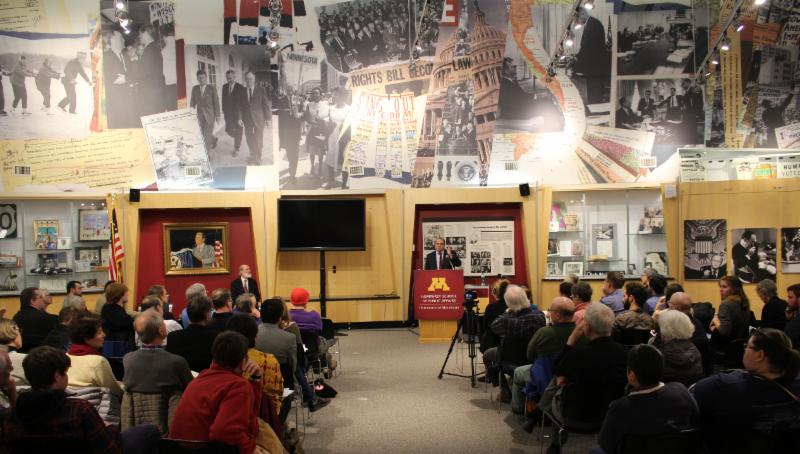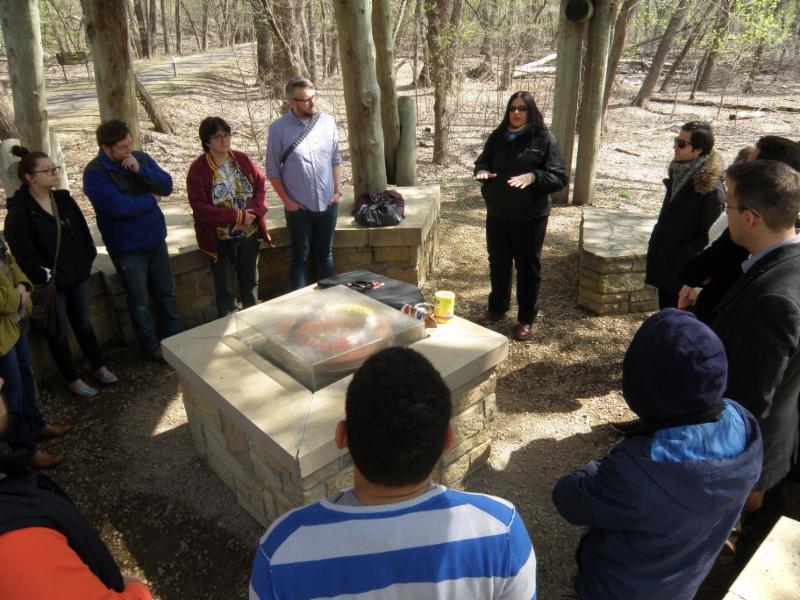On April 23-25 the Center for Holocaust and Genocide studies, along with the Human Rights Program, Institute for Global Studies and the Ohanessian Chair, marked the centennial of the Armenian Genocide of 1915 with a series of events. This included a keynote by Middle East scholar Bedross Der Matossian, an international student conference titled “One Hundred Years of Genocide: Remembrance, Education, Prevention”, a teacher workshop on World War I and the Armenian Genocide, as well as a guided tour of Bdote, a sacred Dakota site at Ft. Snelling State Park led by Professor Iyekiyapiwin Darlene St. Clair.
 The three-day program was opened by the Arsham and Charlotte Ohanessian Lecture, also serving as keynote for the international student conference, delivered by Professor Bedross Der Matossian, University of Nebraska-Lincoln. His talk was titled “The Armenian Genocide Historiography on the Eve of the Centennial: From Continuity to Contingency”, and gave a comprehensive overview of the different approaches to studying and interpreting the Armenian Genocide, highlighting the importance of multi-causal interpretations and micro-historical approaches to understanding the emergence and execution of the genocide.
The three-day program was opened by the Arsham and Charlotte Ohanessian Lecture, also serving as keynote for the international student conference, delivered by Professor Bedross Der Matossian, University of Nebraska-Lincoln. His talk was titled “The Armenian Genocide Historiography on the Eve of the Centennial: From Continuity to Contingency”, and gave a comprehensive overview of the different approaches to studying and interpreting the Armenian Genocide, highlighting the importance of multi-causal interpretations and micro-historical approaches to understanding the emergence and execution of the genocide.
The international student conference on April 24 addressed the topic of one hundred years of genocide from different aspects, and saw student presenters from Armenia, Hungary, the UK, and US. It was moderated by Der Matossian and UMN professors Joachim Savelsberg, Barbara Frey, and Alejandro Baer. First, Angel Amirjanyan and Varduhi Gumruyan delivered their presentations on the psychological effects of genocide and posttraumatic stress in Armenia via Skype, identifying a clear thread of trauma as inherited. Both scholars spoke of the still notable effects of the genocide, even in their generation, manifesting in lack of confidence, inferiority complex, and hesitance to interact with Turkish youth. Both presenters also noted the importance of engaging in a dialogue about the past, and making connections with their Turkish counterparts, in order to minimize tension between the two communities. They also noted, however, that in order for healing to occur, a clear recognition of the events of 1915 as genocide on behalf of Turkey must happen. Peter Kranitz presented on the fate of Armenian refugees in Constantinople, including the problematic “repatriation” of displaced Armenians to the new Soviet Republic from former Ottoman territories.
The second session addressed Armenian and Turkish relations after the genocide. Vahram Ayvazyan spoke about the discrepancies between official state and unofficial, civic society, NGO discourse on the genocide and ways of moving forward, noting that the former is at times inflexible. Torkom Movsesyan raised the question of whether having international judicial bodies tackle the issue of the Armenian Genocide might help mediate the situation, and motivate Turkey’s recognition of the past events. Gevorg Petrosyan gave a presentation on Turkey’s current policy of genocide denial, carried out through the “Shared Pain” discourse, which does not recognize the Armenian Genocide as such, but rather wraps it in with other World War I tragedies, as merely a casualty of the war, among others.
The conference did not just address the Armenian Genocide, however. Lindsay Blahnik talked about the effects of punitive and restorative justice on social cohesion following the Rwandan Genocide, while Tom Dunn informed the audience about the problematic British intervention in the Sierra Leonean Civil War. Finally, Rebecca Shnabel presented on the problematic power relations associated with the translation process, as exemplified by Elie Wiesel’s Night, wherein the original was significantly abridged and modified to be less disturbing to a post-World War II readership. The conference was wrapped up by presentations by Kayla Nomina, speaking on the possibility to determine causal agents of genocide, and the potential for prevention; and Joe Eggers, who presented a comparison of the Native American and Armenian genocides, looking at the role of nationalism in both contexts.
 The discussions continued the next morning at Ft. Snelling State Park, where Professor Iyekiyapiwin Darlene St. Clair, St. Cloud State University, led a tour of Dakota sites and history connected to both the genesis and genocide of the Dakota people: “Bdote” is the confluence of the Minnesota and Mississippi Rivers, the sacred site of Dakota creation stories and the location of Fort Snelling, where many Dakota were imprisoned and died in in the 1860s.
The discussions continued the next morning at Ft. Snelling State Park, where Professor Iyekiyapiwin Darlene St. Clair, St. Cloud State University, led a tour of Dakota sites and history connected to both the genesis and genocide of the Dakota people: “Bdote” is the confluence of the Minnesota and Mississippi Rivers, the sacred site of Dakota creation stories and the location of Fort Snelling, where many Dakota were imprisoned and died in in the 1860s.
Concurrently, a Teacher Workshop on World War I and the Armenian Genocide was taking place on campus. Sessions led by Der Matossian and UMN faculty, staff and community members illustrated various historical perspectives in Europe and the colonies at the imminent approach of World War I.
Over all, the three-day events highlighted the lasting traumatic effects of genocide, even several generations on, but also saw potential in new ways of dealing with the past, including recognizing micro-histories, establishing cultural exchanges, considering different and at times uneasy ways of approaching justice and reconciliation. While the conference also showed that each genocide is a unique event, some parallels were evident, even in contexts seemingly as distinct as US-Native American and Ottoman-Amenian relations.
Arta Ankrava holds an MA in Social Anthropology from Goldsmiths, University of London and is currently a PhD candidate in Sociology at the University of Minnesota. She is interested in diasporic identity, transnationalism, and collective memory. Arta is working on a dissertation about anti-Communism in the Latvian American exile community during the Cold War and through the collapse of the USSR. It is based on her research in the Latvian American Periodicals Collection at the Immigration History Research Center, University of Minnesota.

Comments 1
101 Years of Denial: How Turkish Policy Keeps the Pain of Genocide Alive – The Center for Holocaust & Genocide Studies — May 4, 2016
[…] Armenians as the first genocide of the twentieth century. The centennial was commemorated in the Twin Cities in a series of events, including an interfaith service at the Cathedral of St. Paul and a service at St. Sahag, St. […]